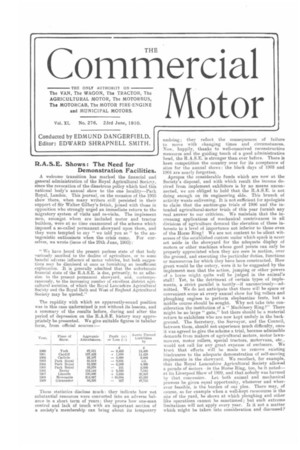R.A.S.E. Shows : The Need for Demonstration Facilities.
Page 1

If you've noticed an error in this article please click here to report it so we can fix it.
A welcome transition has marked the financial and general administration of the Royal Agricultural Society, since the revocation of the disastrous policy which tied this national body's annual show to the one locality—Park Royal, London. This journal, on the occasion of the 1905 show there, when many writers still persisted in their support of Sir Waiter Gilbey's fetish, joined with those in opposition who strongly urged an immediate return to the migratory system of visits and re-visits. The implement men, amongst whom are included motor and tractor builders, were at no time enamoured of the scheme which imposed a so-called permanent showyard upon them, and they were tempted to say " we told you so " to the antagonistic enthusiasts when the crisis came. For ourselves, we wrote (issue of the 29th June, 190.5):
" We have heard the present parlous state of that body variously ascribed to the decline of agriculture, or to some baneful adverse influence of motor vehicles, but both suggestions rosy be dismissed at once as furnishing an insufficient explanation. It is generally admitted that the unfortunate financial state of the R.A.S,E. is due, primarily, to an adhesion to the present permanent showyard, and, contemporaneously, to the increasing number of excellent district agricultural societies, of which the Royal Lancashire Agricultural Society and the Royal Bath and West of England Agricultural Society may be quoted."
The rapidity with which an apparently-sound position was in this case undermined is not without its lessons, and a summary of the results before, during and after the period of depression on the R.A.S.E. history may appropriately be presented. We give suitable figures in tabular form, from official sources : These statistics disclose much: they indicate how net substantial resources were converted into an adverse balance in a short term of years ; they prove how one-man control and lack of touch with an important section of a society's membership can bring about its temporary undoing; they reflect the consequences of failure to move with changing times and circumstances. Now, happily, thanks to well-conceived reconstructive measures and the guiding touch of a good administrative head, the R.A.S.E. is stronger than ever before. There is keen competition the country over for its acceptance of sites for the annual shows: the black days of 1903 and 1904 are nearly forgotten. Apropos the considerable funds which are now at the Society's disposal, and with which result the income derived from implement exhibitors is by no means unconnected, we are obliged to hold that the R.A.S.E. is not doing enough on its engineering side. This branch of activity wants enlivening. It is not sufficient for apologists to claim that the suction-gas trials of 1906 and the intended agricultural-motor trials of this year furnish any real answer to our criticism. We maintain that the increasing applications of mechanical contrivances in all divisions of agriculture demand the elevation of these interests to a level of importance not inferior to those even of the Horse Ring! We are nut content to be silent witnesses of the established custom under which space is never set aside in the showyard for the adequate display of motors or other machines whose good points can only be properly appreciated when they are seen in motion, over the ground, and executing the particular duties, functions or manceuvres for which they have been constructed. How great would be the outcry, were it to be suggested by the implement men that the action, jumping or other powers of a horse might quite well be judged in the animal's stall! Yet, to the detriment of certain types of implements, a strict parallel is tacitly—if unconsciously—admitted. We do not anticipate that there will be space or convenient scope at every annual show for big rollers and ploughing engines to perform elephantine feats, but a middle course should be sought. Why not take into consideration the institution of a " Machinery Ring?" There might be no large "gate," but there should be a material return to exhibitors who are now kept unduly in the background. The Secretary, the Surveyor, and the Council, between them, should not experience much difficulty, once it was agreed to give the scheme a trial, because admissible demands from makers of agricultural motors, motor lawnmowers, motor rollers, special tractors, motorvans, etc., would not call for any great expanse of enclosure. We trust that efforts will be made to remove existing hindrances to the adequate demonstration of self-moving implements in the showyard. We recollect, for example, that the Royal Lancashire Agricultural Society allowed a parade of motors –in the Horse Ring, too, be it noted— at its Liverpool Show of 1899, and that nobody was harmed by that concession. Let both animal and mechanical prowess be given equal opportunity, whefiever and wherever feasible, is the burden of our plea. There may, of course, as for example when a well-kept racecourse is the site of the yard, be shows at which ploughing and other like operations cannot be sanctioned; but such extreme limitations will not apply every year. Is it not a matter which might be taken into consideration. and discussed?
































